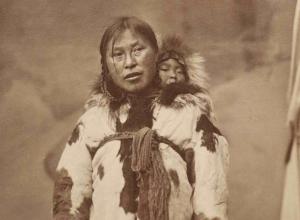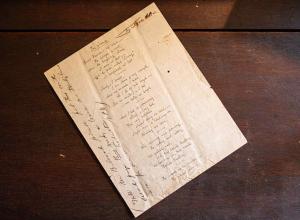Paying tribute to the Atchafalaya Basin
I sit in my living room and watch the Corps of Engineers open the Morganza Floodway releasing the swollen Mississippi River into the Atchafalaya Basin inside Louisiana's Cajun Country. The Basin is the largest river basin swamp in the country and just a month ago I spent a weekend there with my sister and brother-in-law, Misha and Ed Guirard, when Ed's uncle, Greg Guirard, stopped by to give me his book Atchafalaya Autumn II published last October.
Two days after the floodway is open, I watch deer swimming in the flooded waters struggling to reach higher ground. We're told the animals will find refuge and the water may help the crawfish crop plus deliver much needed slit for our coast. Meanwhile I turn to my tried and true therapy--the pages of a book. I grab Greg's Atchafalaya Autumn II for solace, his words and rich photographs paint a comforting but surreal experience as he muses about the decimation of the virgin cypress and today's urban sprawl.
Louisiana has had a long love affair with its rivers and bayous, they bring beauty and romance, commerce and industry, and sometimes death and destruction. After the Great Flood of 1927 a network of locks and levees were built to control the Mississippi River and protect central Louisiana, Baton Rouge and New Orleans. It's been 38 years since the Morganza Floodway opened and although most people will be protected by levees, more than 20,000 homes and camps will be sacrificed.
And what about the environmental impact?
Greg bemoans the mortality of the Basin in his book. "We assume nature can take care of itself. That it can renew somehow. We fail to realize its needs are our needs."
A Cajun author, photographer and lecturer, Greg's family set homestead at the turn of the 20th century outside the small town of Catahoula. He lives on the fringe of the Basin with a bayou skirting the property and the levee in plain view. Now in his 70s he still works the land, builds furniture out of sinker cypress, and goes inside the bayous for crawfish, photographs and peace of mind.
A revision of the first Atchafalaya Autumn, the book boasts 250 color photographs joined by Greg's journal entries and his excellent portrayal of true Cajuns. Natives who earn a living from the Basin's bounty and not the Hollywood brand that feed marshmallows or chicken necks to alligators on press trips.
Set in the autumn months, his photographs highlight sunrises and sunsets with scorching ribbons of clouds in a fiery canvas of orange, pinks and reds. The book spans two decades of Greg's travels introducing readers to the Basin and its people. Peppered with quotes from David Henry Thoreau and William Faulkner, he uses a line from Thoreau in describing his journey, "I went to the woods because I wished to live deliberately..."
He builds a platform for his camera and tripod at Lake Fausse Pointe among a group of three cypress tress overlooking a corridor of trees. Unlike artists, photographers are at the whim of nature's moods. Catching that perfect sunrise is not a chance meeting. It can be a painstaking process as he races to the platform several times fighting the dark, cold and sometimes foggy waters.
And finally a prized photo, what Greg calls a gift, albeit a brief one. The sun slides through a narrow slit on the horizon framed by weeping moss. It's a quick peek as a blue heron perches on a stump inside the shaft of orange sunlight. And some photos just speak for themselves. A late afternoon glow splashes across a flock of white pelicans and a curvaceous cypress tree bathed in the light of a full moon. In addition to the visual splendor, Greg takes time to share the swamp's sweet songs: the early morning call of geese, ducks whistling over the trees, cormorant and anhinga feeding on the water.
The book echoes much of my visits--boney cypress clutching strands of spiraling moss, bald eagles and swallowtail kites soaring the skies, a beaver nursing its young and gators sunning their hides on floating logs. The Atchafalaya Basin holds over 170 species of birds, some with wing spans of eight feet or more. Skilled fishermen catch catfish over five feet and garfish more than 10 feet, alligators 11 to 15 foot long weighing a ton and turtles at 100 pounds. Beavers, nutria, mink, otters, deer, bobcats, coyotes, Louisiana panther and the threatened Louisiana Black Blear all make the Basin their home.
Moved by the infinite beauty and dedicated to Faulkner's stewardship of preservation, Greg records the Basin's sights, sounds and people inside seven self-published books. He closes the book with heartfelt testimonials from locals, journalists and visiting students on the magic of this aquatic countryside. He, like all of us, watch and wait as the Atchafalaya Basin is baptized with the river's rapids. "There is an almost mystical connection between Cajun fisherman and the swamp, a desire not only to see but to touch. To be part of the wilderness...to be in concert with the big woods."
All photographs taken by Greg Guirard. For a gallery of Greg's photos visit www.gregguirard.com.
Louisiana has had a long love affair with its rivers and bayous, they bring beauty and romance, commerce and industry, and sometimes death and destruction. After the Great Flood of 1927 a network of locks and levees were built to control the Mississippi River and protect central Louisiana, Baton Rouge and New Orleans. It's been 38 years since the Morganza Floodway opened and although most people will be protected by levees, more than 20,000 homes and camps will be sacrificed.
And what about the environmental impact?
Greg bemoans the mortality of the Basin in his book. "We assume nature can take care of itself. That it can renew somehow. We fail to realize its needs are our needs."
A Cajun author, photographer and lecturer, Greg's family set homestead at the turn of the 20th century outside the small town of Catahoula. He lives on the fringe of the Basin with a bayou skirting the property and the levee in plain view. Now in his 70s he still works the land, builds furniture out of sinker cypress, and goes inside the bayous for crawfish, photographs and peace of mind.
A revision of the first Atchafalaya Autumn, the book boasts 250 color photographs joined by Greg's journal entries and his excellent portrayal of true Cajuns. Natives who earn a living from the Basin's bounty and not the Hollywood brand that feed marshmallows or chicken necks to alligators on press trips.
Set in the autumn months, his photographs highlight sunrises and sunsets with scorching ribbons of clouds in a fiery canvas of orange, pinks and reds. The book spans two decades of Greg's travels introducing readers to the Basin and its people. Peppered with quotes from David Henry Thoreau and William Faulkner, he uses a line from Thoreau in describing his journey, "I went to the woods because I wished to live deliberately..."
He builds a platform for his camera and tripod at Lake Fausse Pointe among a group of three cypress tress overlooking a corridor of trees. Unlike artists, photographers are at the whim of nature's moods. Catching that perfect sunrise is not a chance meeting. It can be a painstaking process as he races to the platform several times fighting the dark, cold and sometimes foggy waters.
And finally a prized photo, what Greg calls a gift, albeit a brief one. The sun slides through a narrow slit on the horizon framed by weeping moss. It's a quick peek as a blue heron perches on a stump inside the shaft of orange sunlight. And some photos just speak for themselves. A late afternoon glow splashes across a flock of white pelicans and a curvaceous cypress tree bathed in the light of a full moon. In addition to the visual splendor, Greg takes time to share the swamp's sweet songs: the early morning call of geese, ducks whistling over the trees, cormorant and anhinga feeding on the water.
The book echoes much of my visits--boney cypress clutching strands of spiraling moss, bald eagles and swallowtail kites soaring the skies, a beaver nursing its young and gators sunning their hides on floating logs. The Atchafalaya Basin holds over 170 species of birds, some with wing spans of eight feet or more. Skilled fishermen catch catfish over five feet and garfish more than 10 feet, alligators 11 to 15 foot long weighing a ton and turtles at 100 pounds. Beavers, nutria, mink, otters, deer, bobcats, coyotes, Louisiana panther and the threatened Louisiana Black Blear all make the Basin their home.
Moved by the infinite beauty and dedicated to Faulkner's stewardship of preservation, Greg records the Basin's sights, sounds and people inside seven self-published books. He closes the book with heartfelt testimonials from locals, journalists and visiting students on the magic of this aquatic countryside. He, like all of us, watch and wait as the Atchafalaya Basin is baptized with the river's rapids. "There is an almost mystical connection between Cajun fisherman and the swamp, a desire not only to see but to touch. To be part of the wilderness...to be in concert with the big woods."
All photographs taken by Greg Guirard. For a gallery of Greg's photos visit www.gregguirard.com.















